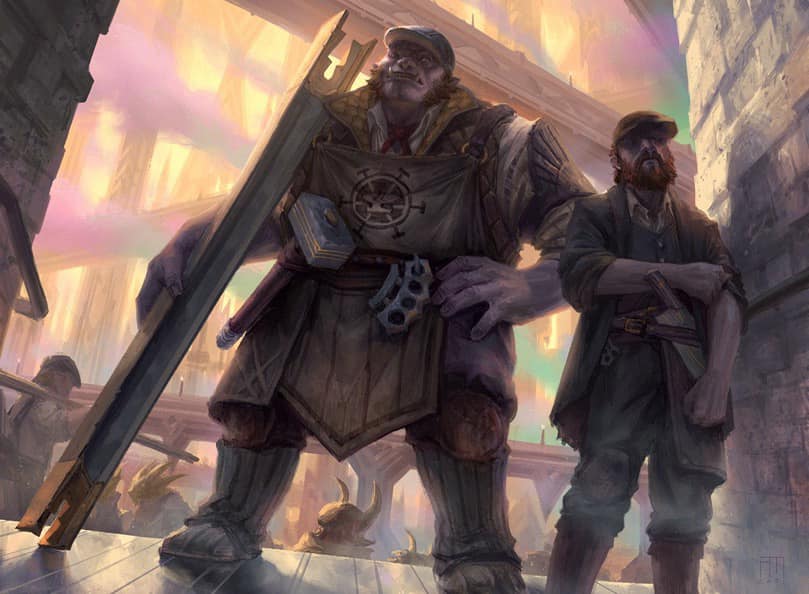I hate looking at my calendar. For the last two years, I’ve had a recurring meeting that an ambitious marketing person put in there that I’ve never once shown up to. It’s regarding (if I had to guess) the blockchain? Every Tuesday morning, I get the notification, click “dismiss,” and move on with my life. Sorry, Mark and the blockchain.
If you’re also calendar-impaired, I have great news for you. Between tomorrow’s Arena Open, the Qualifier Play-In on the 21st, and our end-of-the-month Qualifier Weekend, I can’t remember three weeks where Limited got this much shine. Almost a full month of sealed and draft that can earn you the cold, hard cash you crave or an invite to a set championship? Or an invite to the place you can get an invite? THE POINT IS it’s a great time to be alive if you like having a giant sideboard.
Since all of these events depend on you having some amount of alacrity when it comes to the Day 1 sealed portion to see Day 2, I wanted to immerse myself in this world, six packs of Streets of New Capenna (SNC) at a time. As of this writing, I’m on the 17Lands leaderboard top 10 in Match Wins, Trophies, and Trophy Rate. I’m surprised because I’ve tried some truly awful decks in the name of science. When sticking to the best color combination, I won 81.25% of my games.
My advice, based on what I’ve seen so far? Play the Best-of-1 queue all the way to your seventh win with Bant and a Day 2 invite. If you’re shooting for Best-of-3, I’m Jeff Prost: got nothing for you. Head back to camp.
Format Speed
First, I think “format speed” is a waste of time in almost every sealed environment and SNC is no exception. There can be fast decks. I wouldn’t build any differently than usual, other than noting that attacking tends to be strong here. If you’re playing defensive cards, they need to be fully loaded with four toughness or a shield counter on them. Someone asked why a card like High-Rise Sawjack isn’t any good the other day on Reddit. The short answer is it trades too often because of it’s awful three toughness. Three toughness stuff dies here. That’s what you need to know about the format speed.
Red is Awful
If we look at the Top 50 cards by Game In Hand Win Rate (GIH WR), we have only Professional Face-Breaker making the list as a mono-red card. Expanding to multicolor and we see Hostile Takeover at #6, Ziatora, the Incinerator at #18, Ob Nixilis, the Adversary at #35, Jetmir, Nexus of Revels at #37, and finally Fleetfoot Dancer at #42. Six total cards, half of which are mythics. There are five blue commons in that same top 50.
Your big issue is that red is playing at sorcery speed in an instant world. Bant, Azorius, and Selesnya decks are out there attacking like nobody’s watching during combat while you stare at the Strangle, Light ‘Em Up, or Ready to Rumble in your hand, afraid to get in there like a boy at a middle school dance. Outside of Call in a Professional, you’re also desperate for ways to interact with creatures that have shield counters on them, aka the bane of your existence.
Red is usually reliable for your secret reach creature, but here we’re left with Wrecking Crew, a fairly meandering body that comes in as too little, too late in most games. If you do find yourself in red, make sure you’re saving removal against the flyers in Brokers, as you shouldn’t have much trouble winning the ground game. That is, if you stay alive.
You Shouldn’t Splash Red
Either your pool leaves you no choice to play it or you stay away. Them’s the rules. You know those red cards I mentioned above? Seems like cards you should play, right? I think that’s the trap.
Let’s look at a card like Inspiring Overseer. Using that same GIH WR stat, if it’s in our opening hand or we draw it, we’re winning 62.1% of those games. If we don’t? We lose 45.3% of those games. That’s a Vanilla Ice level swing, right? Compare that to games where we cast Ob Nixilis; if we do, we win 58.8% of the time but lose 57.3% of the games we don’t. That’s horrible, but right next to it in the “bottom 10” we see Hostile Takeover and Professional Face-Breaker, with Jetmir and Ziatora also hanging out. Yikes City is waving its red flag.
What this tells us is that people see these big, powerful cards and do one of two things: build the wrong colors to take advantage of them or splash them into decks where they won’t work. I was raised by the “play your bombs” generation of sealed deck creators and while I love it in theory, it doesn’t work here with red cards unless you open all red cards. Even then, I’m holding my nose and building the 40.
Other Than Lands, Ignore Your Colorless, Too
As tempting as it is to buy the hype around Quick-Draw Dagger or hope to nab some value against a Dimir opponent with Unlicensed Herse, the only artifacts I’m tempted to play are Halo Scarab or Ominous Parcel. Both are essentially fixing for decks that didn’t quite crack the mana base they needed to for a highly functional three-color deck. If you have to play both, consider that you’re being too greedy and should just cut back playables in your splash color.
I’m also happy to play an Obscura Storefront or Cabaretti Courtyard in my Bant decks. As the man named after an uninspired mix of ground beef molded into a pan once said, two outta three ain’t bad. Honestly, I think having the right mix of lands is one of your biggest keys to winning in this format, so a couple of sacrifice-to-draw duals can make all the difference here.
Brokers Are, Sigh, Still the Deck to Beat
Similar to draft, the Bant deck still wins. In sealed, it’s doing things a little differently, relying more heavily on evasion and connive than the perfectly crafted tempo turns. If you’re not familiar with Bant as a draft deck, check out my primer (in a new tab) while I wait for you to check back in.
You good? Okay, then.
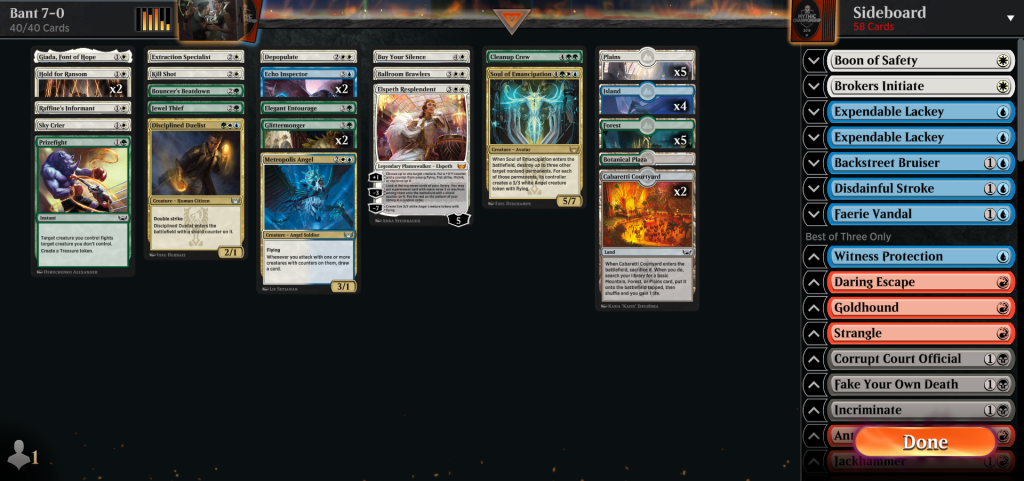
In terms of ratings changes, Disdainful Stroke is a perfect one-of that gives you a cheap answer to bombs the deck can struggle to interact with since it’s not racing around/tapping/bouncing them as effectively. Witness Protection is a card I loathe in draft but plays so well here, basically as a You Are Already Dead without the card draw when played post-combat or a way to stop an opposing Jaxis from troublemaking. I’ve ended a few games with a well-timed Revelation of Power, either eating an opposing flyer or making one out of nowhere. Make sure you have enough counters in your deck to get the keywords or you’re wasting everyone’s time. Speaking of time, the games go long enough that I’m happy with a single copy of Case the Joint
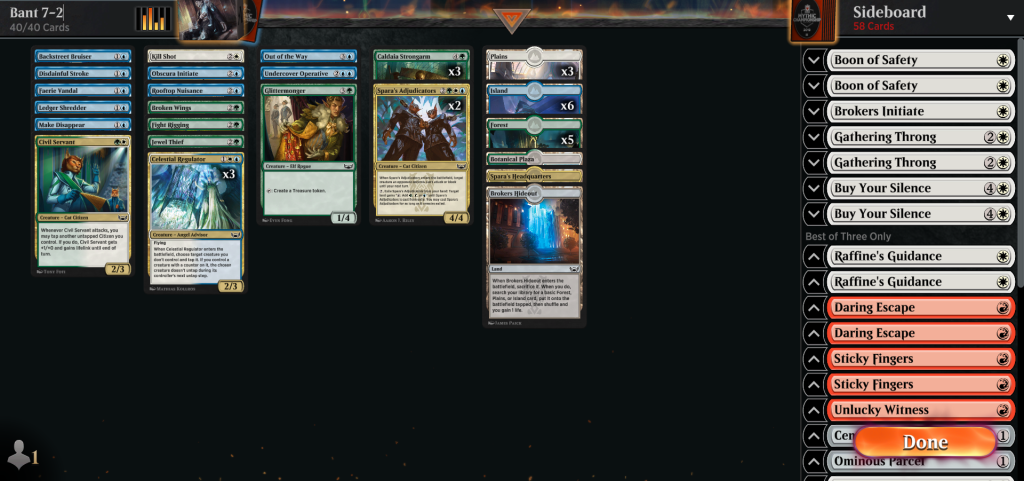
I’m down on most two-drops that don’t include the word “Raffine’s” or “Citizen.” Note that the Citizen rule doesn’t apply to Speakeasy Server, which feels like it would be a slam dunk. The problem? It feels like you spend a lot of early turns trading off creatures, so it winds up as a fairly vanilla 3/3 for five. Again, three toughness is not where you want to be.
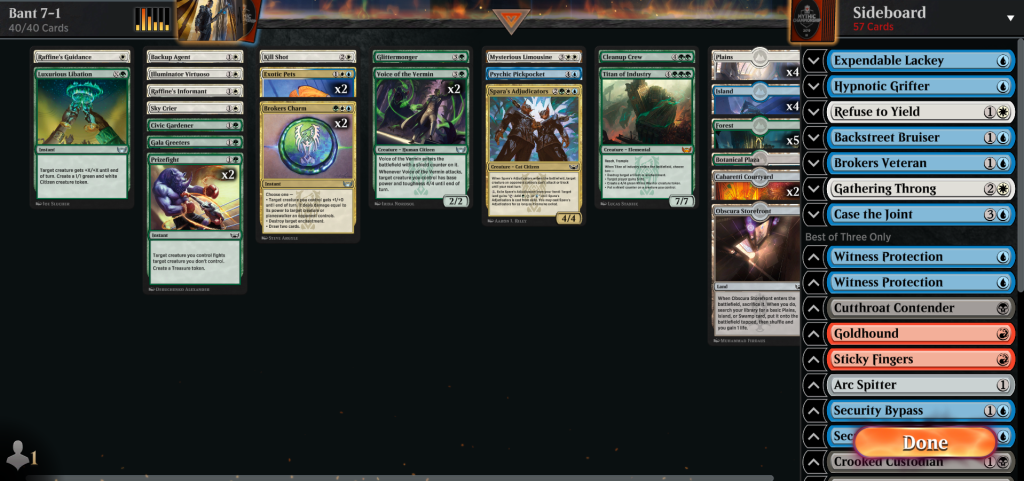
For our uncommons, Hypnotic Grifter is wildly good in sealed and I’m trying to get rid of one as soon as it enters the battlefield for an opponent. Looting multiple times per turn in the late game plus growing larger is a beast of a card. Freelance Muscle wins games here and there compared to draft where it can feel a tad slow. On the flip side, Ceremonial Groundbreaker has been awful for me and should not be considered an auto-include. You must have a critical mass of Citizens or the equip cost negates so much of the value, even in a slower game. Check your counts.
I’m willing to play all of our hybrid mana rares in Toluz, Clever Conductor, Rigo, Streetwise Mentor, and Jinnie Fay, Jetmir’s Second, ranked in order here. When it comes to hideaway cards, Rabble Rousing and Fight Rigging are in a different solar system compared to Wiretapping, a card I will never cast. Rousing and Rigging get you that free card so frequently it feels unfair considering all the other bonuses. Always tuck something under there you’d love to have right before combat as a result.
Beating Brokers
First, I would desperately try to be in Obscura so you’re at least Brokers Lite. Black gives you options to attack their hand in Corrupt Court Official, Extract the Truth, or Nimble Obstructionist, which can be a decent tactic if they’re as connive-focused as they should be. Plus, casting Inspiring Overseer is great in every deck, it turns out.
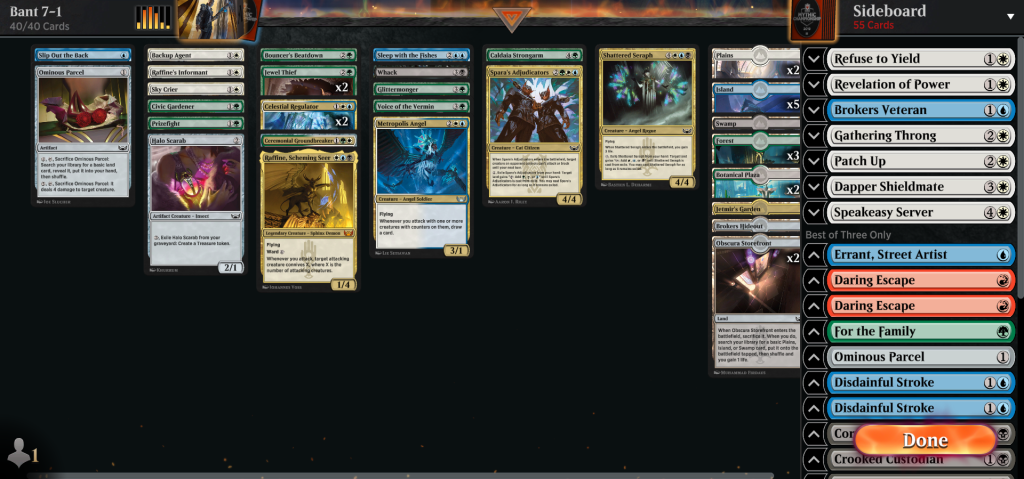
Second, remember that this deck is much easier to deal with than draft, where they have a massive advantage on turns two and three. If you can get on the board early and pressure them, it’s possible they stumble out of the gate. Creatures that help you in the situation: Girder Goons, Snooping Newsie, Echo Inspector, and Dusk Mangler or Queza, Augur of Agonies for the last few points of lethal. Key spells include Fake Your Own Death, Grisly Sigil, Out of the Way, Murder, Make Disappear, and Run Out of Town. You need to tempo them back and gain some life along the way.
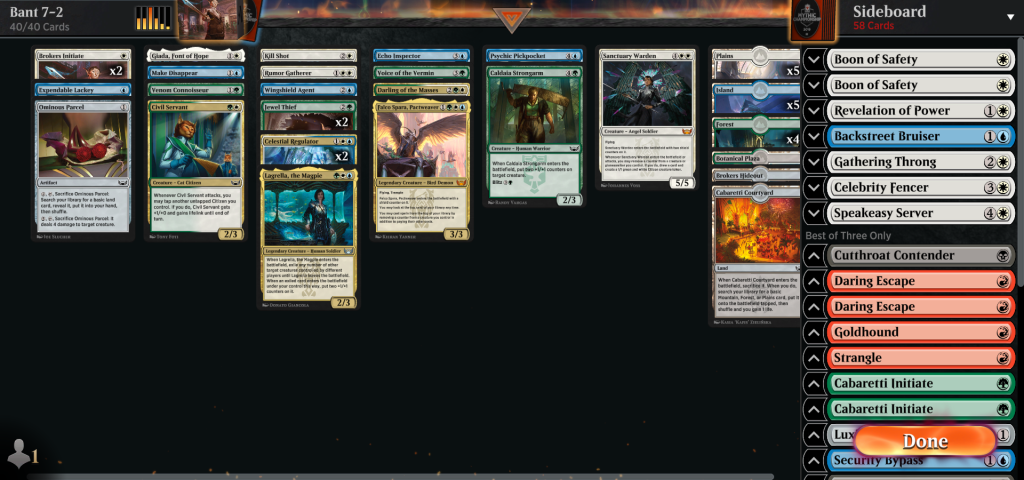
If You Absolutely Must, Play Red as a Core Color
Drop from the event? I would give you a bunch of advice here, but again, you should only be in red if you have almost all your playables in it. At that point, I would prioritize whatever you can do to operate better at instant speed. Make sure you can get your charm mana online without too much brain damage or loss of battlefield presence. Play Torch Breath for opposing blue flyers. And, no matter what you do, reconsider every card you have to see if there’s an option to play every other color.
Final Thoughts
While there’s a clear favorite in terms of decks, the changes in prize structure mean that if you reach day two, you’re at least getting your gems back. That’s pretty sweet and should encourage people to take a second run if their first pool is garbage. Just remember that your budget is up to you, so make smart financial decisions and have fun out there. It’s going to be a long three weeks of limited.

